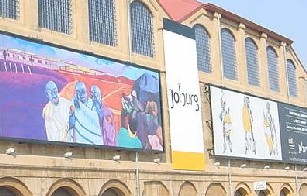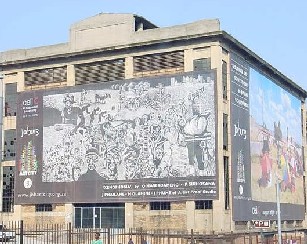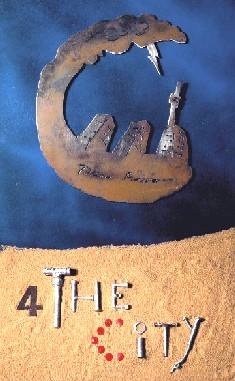 |
Spot the 'C' as Jo'burg goes red
Lucille Davie
29 August 2002
IT was "creative, with a touch of red" on Tuesday night at the unveiling of the Cell C artworks, a "celebration of Johannesburg in art", at the Electric Workshop in Newtown.
Red is what the invitation said and red is what the guests did: there were flashes of red ties, red scarves, red jackets, red caps, even red devil's horns, worn by the guests. But this style didn't disguise the creative artworks displayed for the first time, in the Workshop.
Thirty-five artists were commissioned, with preference given to artists living and working in the city, who have "a work interest in the city of Johannesburg or in art for social development". Artists were told to include a C shape in their works and to include the words 'for the city'.
The completed art includes a mosaic mielie, various profiles of the city, a photograph of pavement fruit for sale, train commuters, a protest march, and a photograph of a sangoma. The C is represented in some of
the works as a half moon, a C-shaped index finger and thumb, windswept ties in a C shape, birds in the sky, and smoke from a brazier curling up in the skies of Johannesburg in a C shape.
The artworks have been blown up and erected on buildings around the city, and those in Newtown have already transformed the area, bringing colour and excitement to a once drab area. They will remain on the buildings for a year.
The works were commissioned by Cell C, South Africa's third cellphone operator. Cell C was commended by Gauteng MEC for arts and culture Mondli Gungubele for "one of the most inspired and forward-thinking brand campaigns to hit South Africa in a long time".
"Cell C is to be commended for taking its message downtown and, by so doing, casting a powerful vote of confidence in the drive to revitalise the inner city," said Gungubele. Other speakers at the unveiling were city councillor for finance Kenny Fihla, CEO of Cell C Talaat Laham, and Neil Fraser, CEO of
the Central Johannesburg Partnership
The Workshop, one of the earliest buildings in the city, which once powered the city's early trams, was transformed into an elegant red and black art gallery, with scattered red bar tables and black curtains draped around the walls. The central steel supports added drama to the setting, lit by red lights and allowing a view down onto the scene, from its stairway.

Electric Workshop gets a paint job
The original artworks were on display in the Workshop, and hundreds of people wandered around enjoying them. There were paintings and sculpture, pictures using plastic bags, others used wire mesh, even poems and photographs.
"It took six specialised rope access teams to rig and erect the works over five days," according to Cell C. All the works are to be lit at night.
"Cell C for yourself" flashed around the tall walls of the Workshop, illuminating
a pair walking in the crowd, playing a violin and accordion. They were replaced by a noisy 20-member brass band, announcing the guest speakers.
Neil Fraser, CEO of the Central Johannesburg Partnership, one of the partners in the initiative, said that the project had two objectives: "To expose art as never before to the man in the street and getting people to talk about it; and, to change perceptions about the city by showing people what's happening there."

Huge artworks hide the otherwise shabby exterior of Turbine Hall
Cell C has also contributed R500 000 to another art project, the JHB Art City project, which also plans to erect large artworks around the inner city buildings. Other partners in this project are the City of Johannesburg, the Johannesburg Development Agency, the Johannesburg Inner City Business Coalition, supported by Business and Arts South Africa. The art city project
differs slightly in that it is an art competition - the Cell C art was all specially commissioned.
Meanwhile, another art and environment project, on the M1 (north and south) of the city, is in place, sponsored by the provincial conservation department. Some 10 large billboards have been placed on bridges across the freeway, with the theme "Recycle your attitude".
If you thought that Johannesburg is no longer a city but a wonderful outdoor art gallery, you'd be right.
Newtown is one of the city's oldest districts, housing the fresh vegetable and fruit market building, which has been transformed into the MuseuMAfricA and Market Theatre, the latter presently undergoing renovation.
The area has been earmarked as one of the city's regeneration projects, and is becoming an entertainment hub for the city, with a busy programme planned for the World Summit.
Nearby, the Metro Market is almost complete, moving the city's street hawkers into its open hall. It is
also accommodate the city's taxis. The new Nelson Mandela Bridge, linking Newtown to Braamfontein, reaches across the train lines, and will be finished later this year.
Source: City of Johannesburg web site


|  |
 |

 |
 |
 |
 |
Metal sculptor David Rossouw, whose work has given Jo'burg some of the world's artiest security gates, uses rusted iron, nuts and bolts in this work |
 |
Art from trash
The Fantastic Rubbish Art Exhibition, showcasing how valuable rubbish can be, runs at the Ubuntu Village at the Wanderers in Johannesburg until 6 September as part of the World Summit. 
Recycling attitudes to waste
A project aimed at cutting down on waste is being piloted at the World Summit on Sustainable Development, with recycling stations being placed at all Summit venues, and artworks on billboards challenging people to "recycle your attitude". 
World Summit special
One of the largest ever gathering of global leaders takes place in Jo'burg in August and September. Visit our Summit page for world-ranging news, views, features, info, links and more! 
|
|
|





















